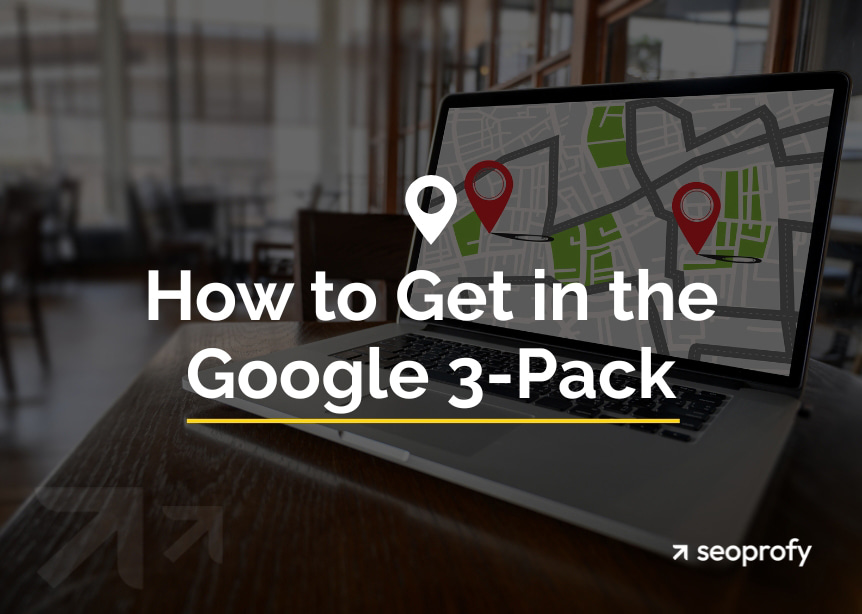To get the most out of SEO, it’s necessary to pick the right keywords for your strategy. If you’re not sure how to do this, we’ll show you the exact process. In this guide, you’ll learn how to find low-competition keywords, understand search intent, and, most importantly, choose SEO keywords with the highest potential for your business.
Keywords are the foundation of any SEO campaign. They can help you drive more of that valuable traffic to your site and improve rankings. But if you don’t pick the right keywords for SEO or overlook the search intent, you might not see great results from your optimization strategy.
With that being said, how do you decide on keywords for SEO that will be effective for your business? Read on to find out.
- Identifying search intent behind keywords can help you understand what type of content you need to create to rank positively on Google
- Free tools like Google Keyword Planner and AnswerThePublic are great for initial research
- Competitor audit can be a quick way to find keyword ideas for your strategy
- Prioritizing low-competition keywords increases your chances of positive ranking in search results
- SERP analysis can show what types of content perform best for your target keywords
- Organizing keywords into relevant categories can speed up your content creation process
Key Steps in Choosing SEO Keywords
From initial research to checking competition, here’s how to choose keywords for SEO:
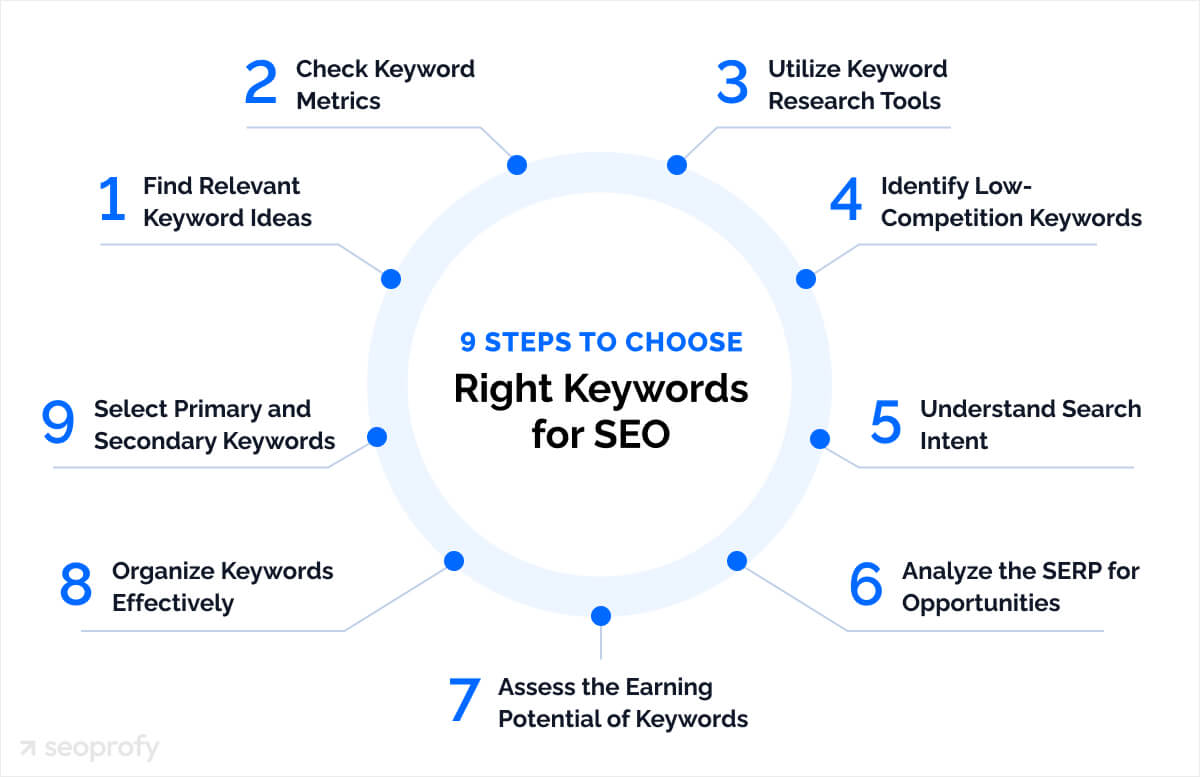
Find Relevant Keyword Ideas
The first thing you need to do is to find as many keyword ideas as possible. A few ways to do that are the following:
- Check what keywords your competitors are using
- Use your seed keyword to find similar ones
- Look at some of the search terms you already rank for
Keyword research tools like Ahrefs or Semrush can help you with this task. Similarly, there are several AI-powered tools you can use for initial research. But they are not always precise.
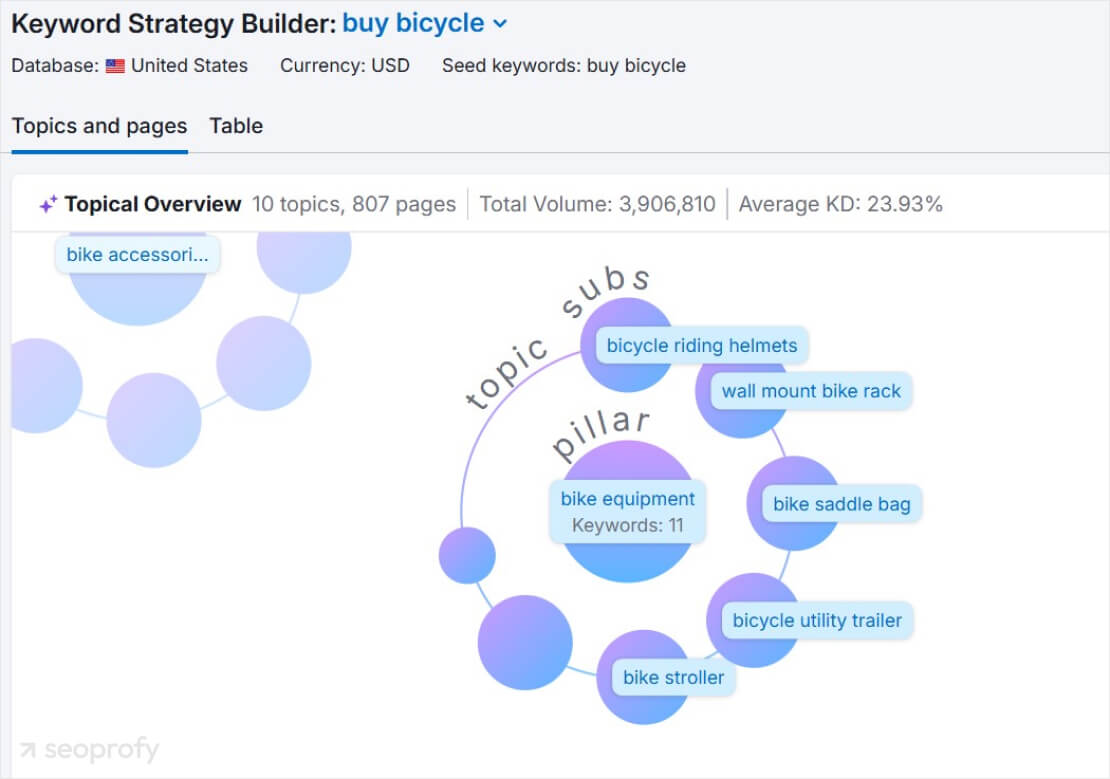
If you prefer free options, then Google Keyword Planner, Google Search Console, and AnswerThePublic are great tools to help you find keyword ideas. For instance, here are some examples of keywords for jewelry websites in AnswerThePublic:
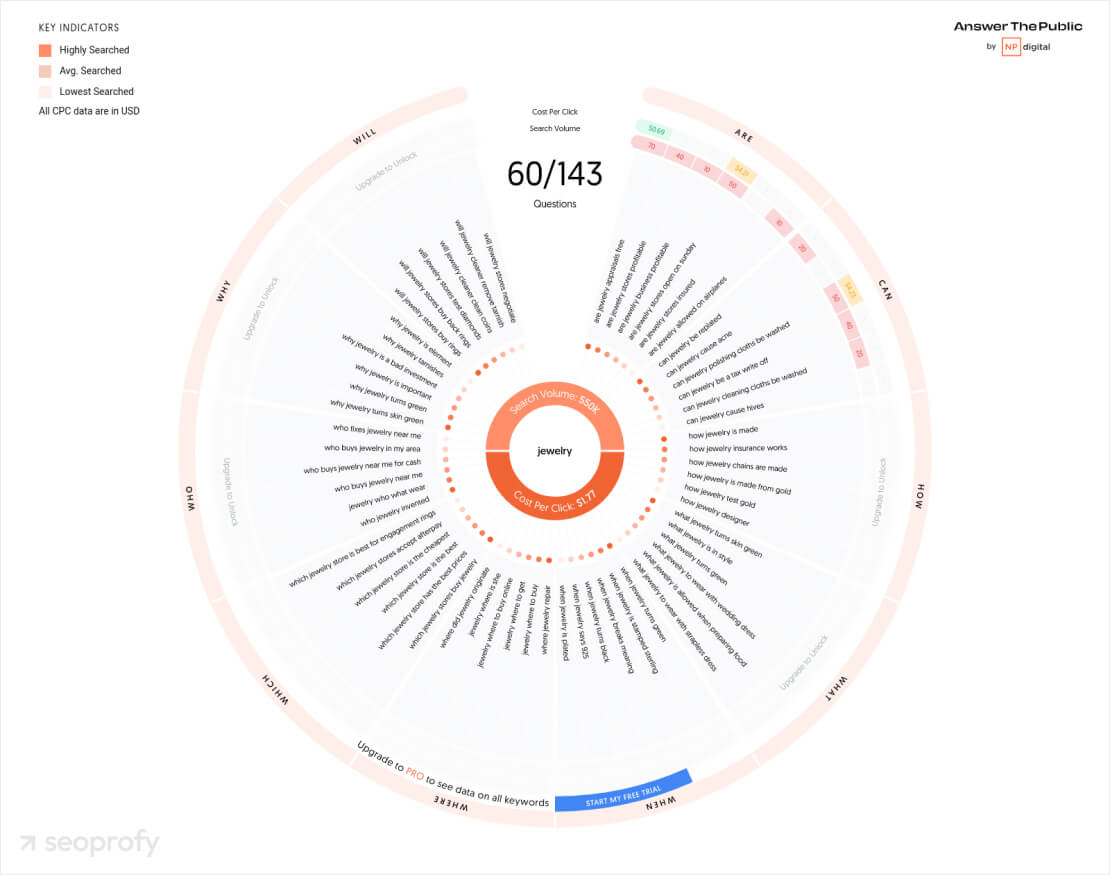
Check Keyword Metrics
Your next step on how to choose keywords for SEO is to check how many people search for these terms, how competitive they are, and how easy it’ll be to rank for them. In other words, you need to look at metrics, such as:
- Search volume: This is the number of times users search for a keyword. You can either select a global search or a specific country.
- Keyword difficulty: This is a score from 1 to 100 and shows how difficult it is to rank for a certain search term.
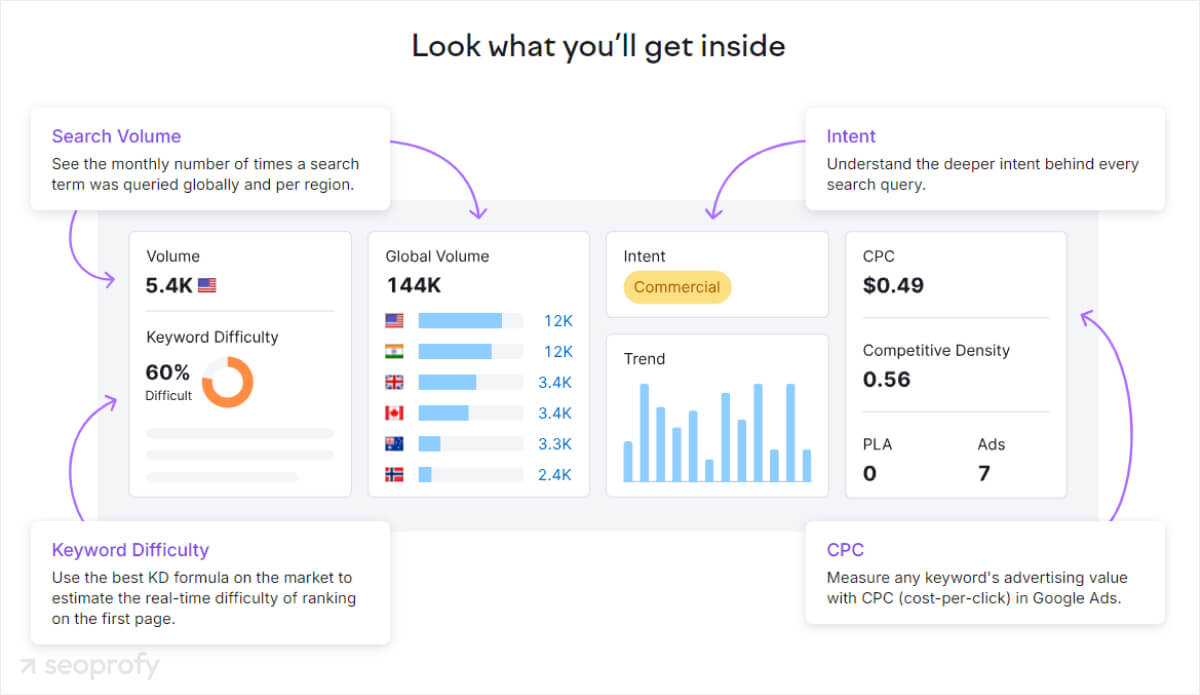
When selecting the keywords to add into your SEO strategy, try focusing on ones which have a good balance between these metrics. Furthermore, it is useful to investigate competition for those keywords and find out what websites already rank for them. We’ll discuss this more later.
Utilize Keyword Research Tools
We’ve already mentioned some of the keyword research tools earlier but now let’s discuss them in more detail. The most popular paid options out there are Ahrefs and Semrush.
To find the right keywords for SEO with Ahrefs, simply enter one or several seed keywords into Keyword Explorer and choose your location. This provides many search terms to target.
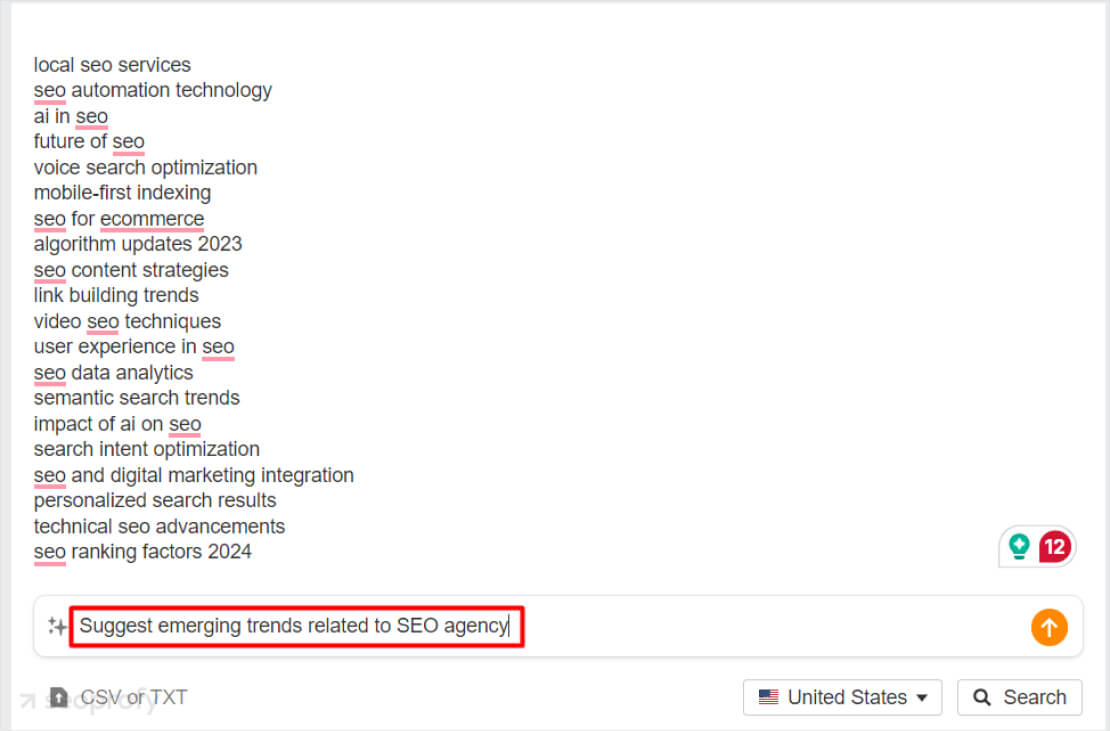
In Semrush, navigate to Keyword Overview and type in your seed keyword. Then hit search.
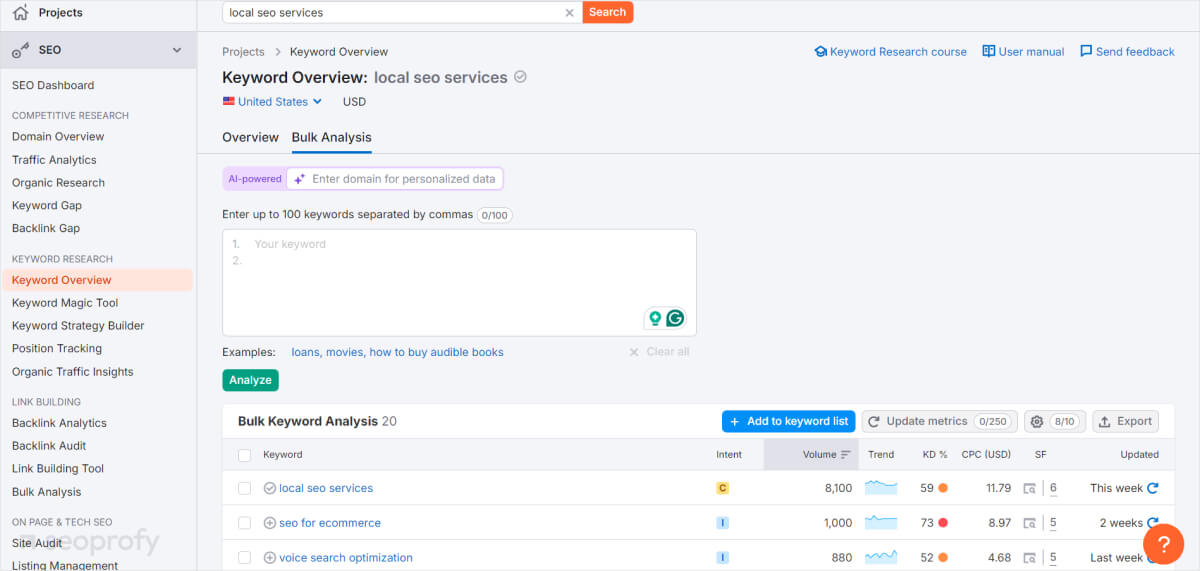
A free alternative to the mentioned tools is Google Keyword Planner. Although it’s mainly used for advertising, it can still offer some insights into metrics like monthly searches and competition.
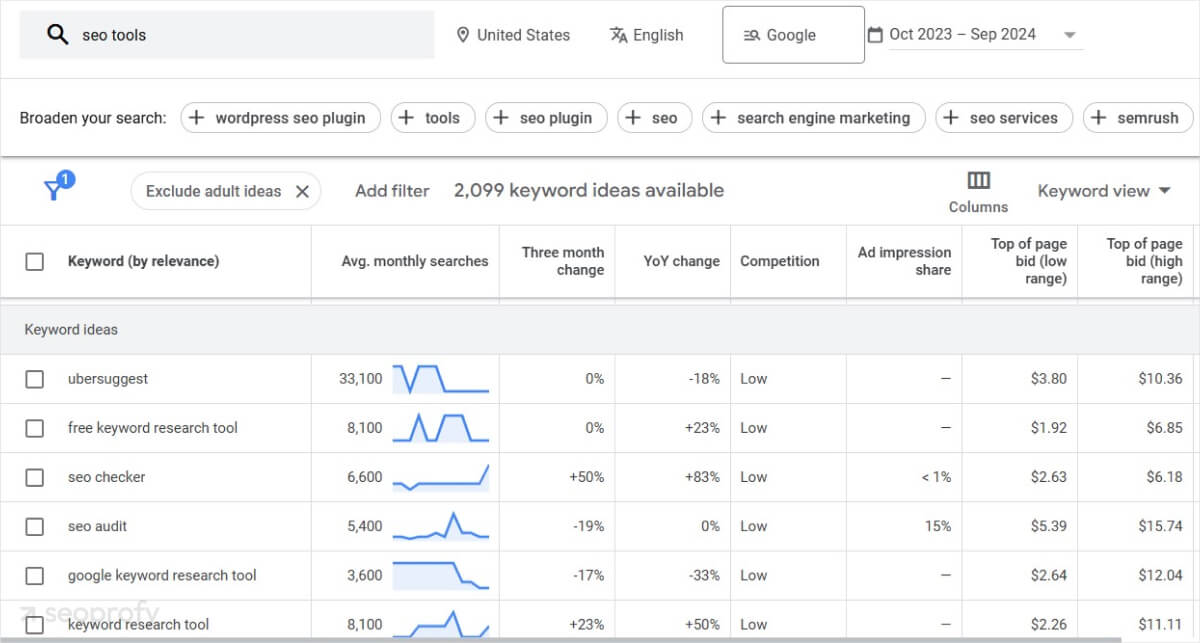
Identify Low-Competition Keywords
Now that you have your list of keywords, it’s time to scope out your competition. Type in the keyword in the tool of your choice and look at the Keyword Difficulty (KD) scores. As we mentioned, this metric measures how hard it is to rank in Google’s top 10 search results on a scale of 1 to 100.
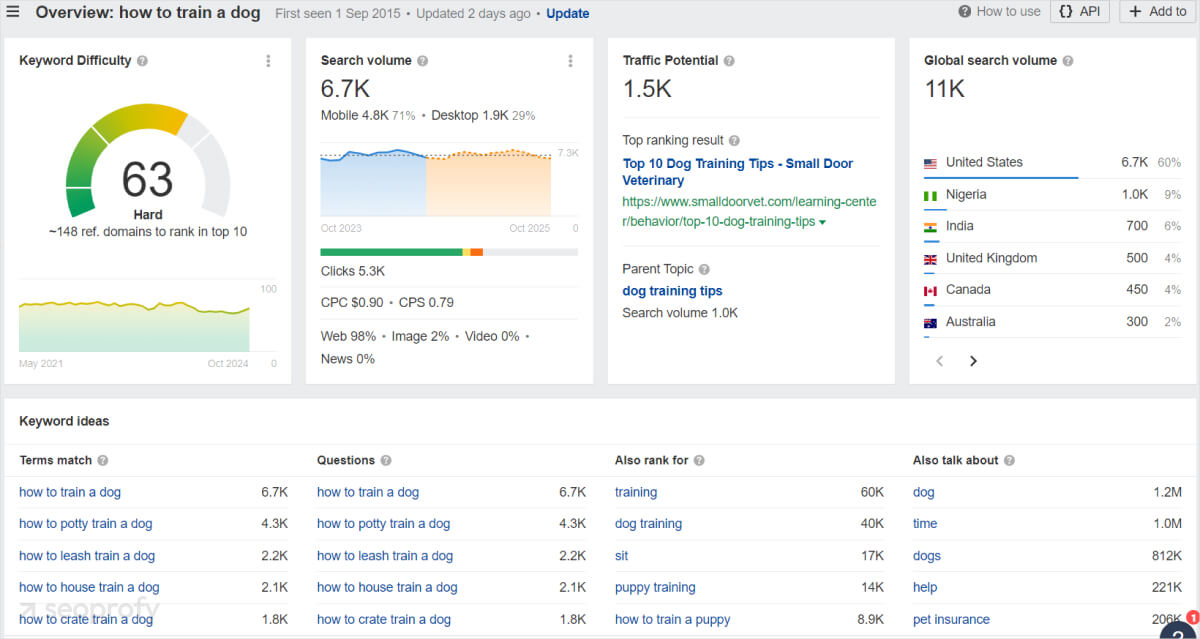
You’ll mainly want to prioritize keywords with relatively low difficulty scores so that you can rank for them more easily. At the end of the day, if the keyword from your list is too difficult to rank for because of high competition, it is probably not worth your time and effort.
You can also filter your keywords and set the difficulty score between 1 and 30. This gives you a good starting point for choosing keywords. After that, check the search volume to see if they’re a good fit for your campaign.
The search volumes of the keywords will probably be lower once you set the filter. But you’ll be more likely to rank for them. Finally, check if the overall competitiveness of your keyword cluster is low to confirm you’re targeting the right opportunities. We’ll talk more about keyword clusters later on.
Understand Search Intent
To choose the right keywords for SEO, you need to understand the search intent behind a query—primarily because you want to know why someone is looking up a certain term and what they want to get from the results. There are four known categories when it comes to the intent:
- Informational
- Navigational
- Commercial
- Transactional
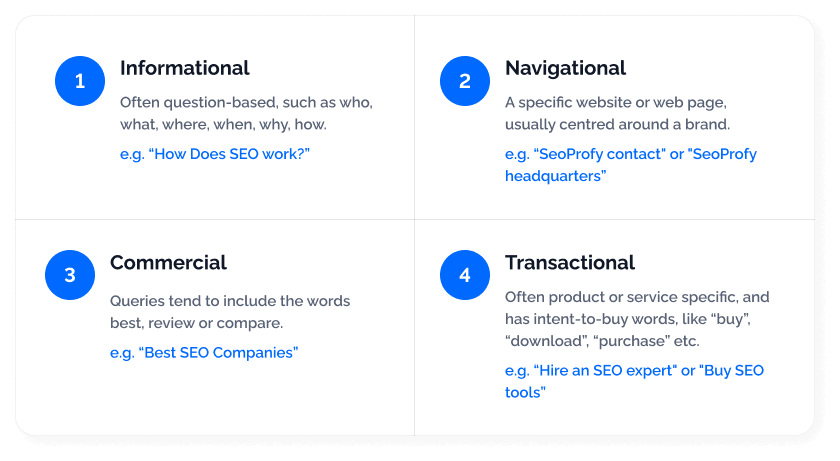
Informational intent is when people are looking for information, like “how to start a blog.” On the other hand, navigational intent is when a user needs to find a certain page, for example, ‘”Facebook login.” Transactional and commercial keywords, such as “buy iPhone 16” or “best laptop deals,” show that the person is further along in their buyer’s journey.
Understanding the search intent behind your keywords is important for your SEO strategy. It helps you identify which type of content you need to create to rank for that keyword.
One of the best ways to identify the search intent is to take a look at the search engine results pages (SERPs). Check what types of content appear there. If you see blog articles, then the intent is informational. Conversely, if it’s service or product pages, then the intent is commercial.
The search intent also can give you insight into which part of the buyer journey your customers are on. For example, if they are looking for information, they are still in the awareness stage and this means they are not yet ready to buy. Similarly, you can check the search intent in the keyword research tool. Here’s how it looks like in Semrush:
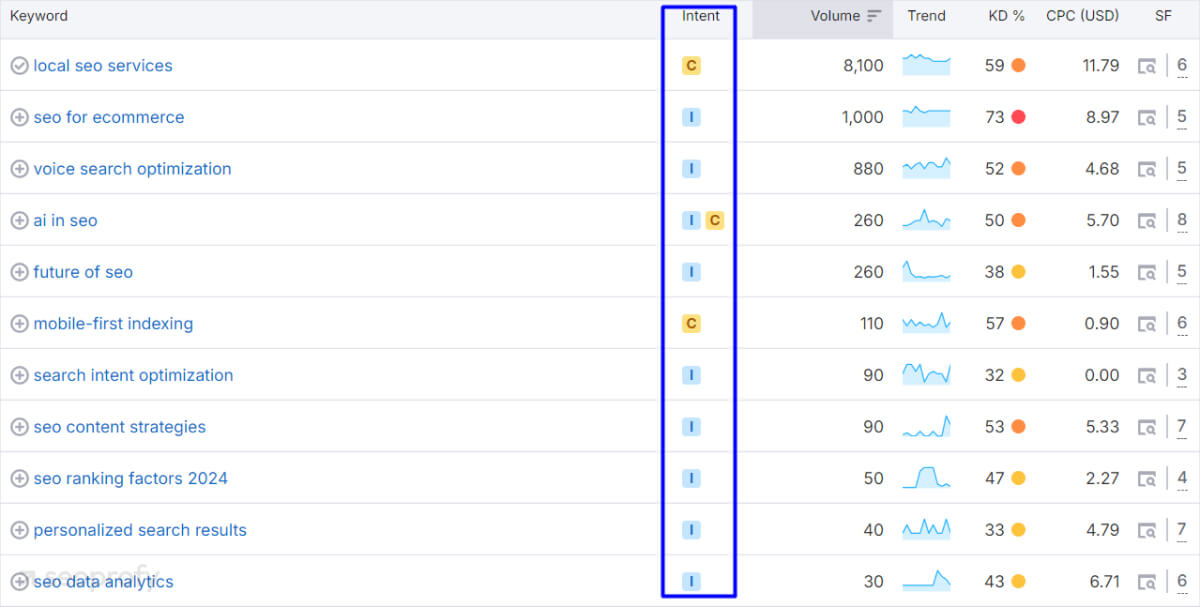
Most of the tools offer a filter option. This means you can narrow down the keywords with the search intent types that matter most to you.
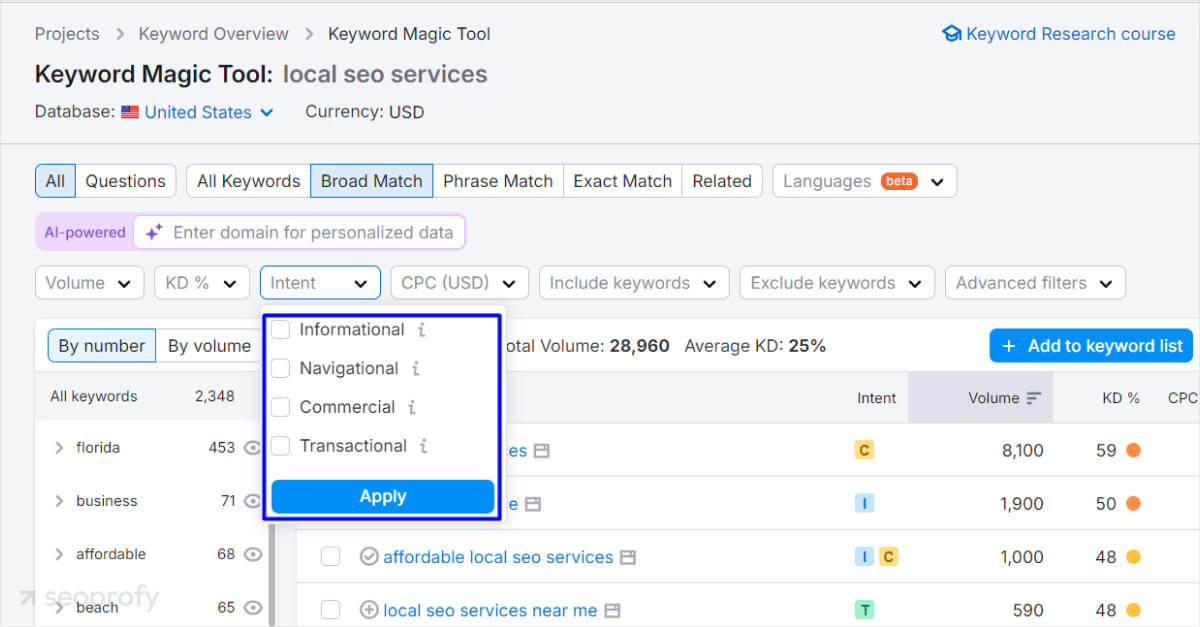
The tools will help you figure out the search intent quickly and without having to check every single search result. That being said, you still have to look at the SERPs for your main keywords. This leads us to the next section.
Analyze the SERP for Opportunities
The SERP analysis means looking at search results pages to see who’s ranking for your keywords, and what content they post, as well as checking rich results like featured snippets and People Also Ask boxes.
Doing a SERP analysis helps you to see what already works for other sites and what kind of content you need to create to rank well in search engines. For example, are these the top results listicles, in-depth guides, or product pages? What format and style is more prevalent?
Additionally, you’ll be able to see what else people are searching for. Sections like “People Also Ask” can give you ideas for extra topics or questions, which you can later cover in your content.
To analyze the SERP, simply type in your keyword into Google and work your way through each result. Take note of the meta tags each website is using, the heading structure, and how comprehensive their content is.
Similarly, you could use tools like Semrush or Ahrefs, which enable you to check all this information much faster. Here’s how you can do it using Ahrefs:
- Go to Keyword Explorer
- Enter your target keyword and location
- Hit the “Search” button
- Go to the SERP overview
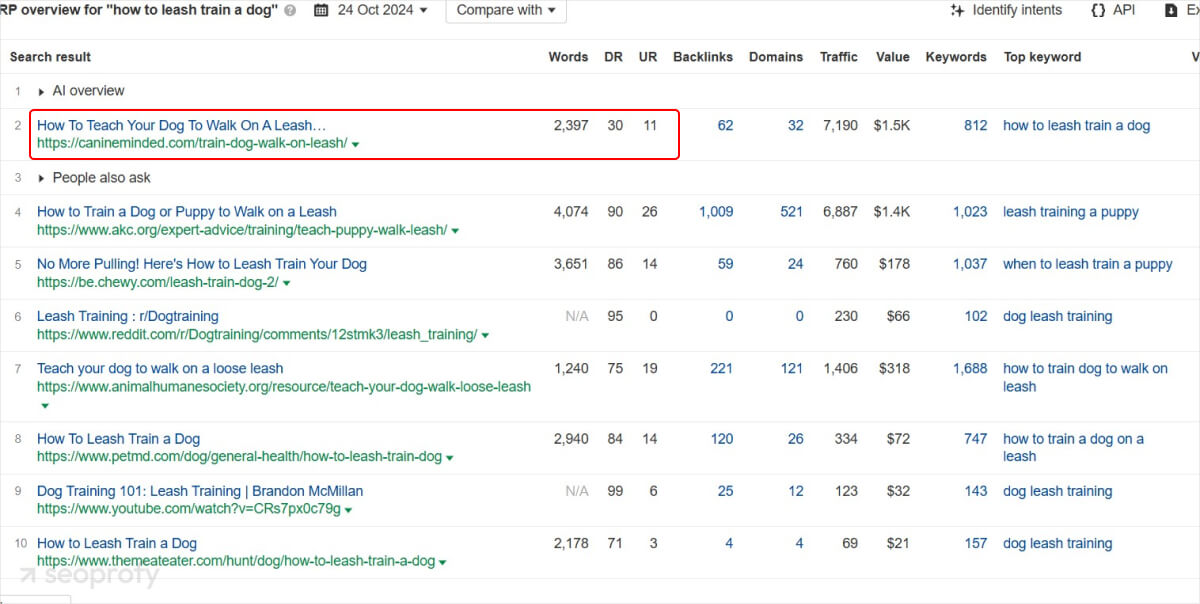
There you’ll see a list of sites that rank for your keyword. This method is great because you don’t need to check each site manually. You’ll also be able to see other metrics like:
- Domain Rating (DR)
- The number of backlinks
- The number of referring domains
These metrics show how easy or hard it will be to compete with other websites for your chosen keywords. Domain Rating (DR) is one of Ahrefs metrics, which tells you how strong a website’s backlink profile is, rated from 0 to 100.
Even though it’s very much possible to outrank sites with a higher DR, a smart move is to focus on pages in the top 10 that have a DR similar or lower than yours. This way, you’ll have higher chances of making it on the search engine results pages (SERP).
Finally, the results in SERP will help you assess the potential click-through rate (CTR). CTR is the amount of times the link to your page was clicked on. It’s believed to play a role in search rankings, too. A higher CTR tells Google that people find your content relevant, which can help improve your rankings over time.
One of the best ways to improve your organic CTR is by landing in a featured snippet. This is the top box in search results that highlights an answer. It can make your content more visible and drive more traffic to your site. There are a few ways you can improve your chances of being featured:
- Use clear headings and bullet points to help Google pull answers directly from your page
- Provide direct answers to common queries in your content, ideally early on
- Incorporate relevant questions to increase the likelihood of being featured in snippets or the PAA section
- Add schema markup to help search engines better understand your content and get you featured.
Ahrefs Keyword Explorer tool has a metric called Clicks which shows the estimate of how many users will click on it. This can help you filter out terms with a very low CTR and find the right keywords for SEO.
Assess the Earning Potential of Keywords
High search volume and low competition are good, but the real question is: will that keyword drive revenue for you? Ahrefs’ Keyword Explorer offers two key metrics to help you figure that out: Cost per Click (CPC) and Cost per Search (CPS).
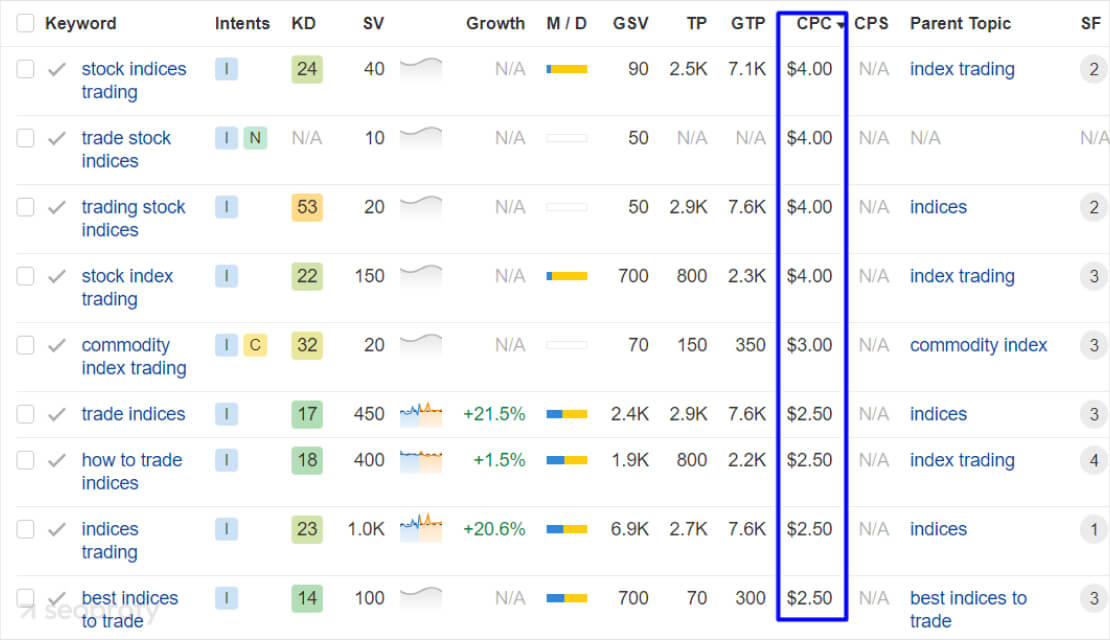
CPC is what advertisers are willing to pay for each click on their ads for a specific keyword. For example, if you see that “online legal services” has a CPC of $30, that means businesses are ready to spend $30 for every click they get on ads targeting that keyword.
Generally speaking, the higher the CPC, the better the keyword. That means people who are going to search for it will more likely buy a product or subscribe to a service.
Then there is CPS. It gives you a slightly broader look at the keyword’s overall value and calculates an average cost per search based on the total ad spending for that keyword. So, if you find “law firm marketing” to have a CPS of $3, that can help you figure that advertisers can earn around $3 for every single search someone does using that keyword.
It’s a good idea to keep an eye on both CPC and CPS. If a keyword has a high CPC and CPS, that usually means strong competition with a good chance of attracting users ready to convert.
Organize Keywords Effectively
To get the most out of your keyword research process, you need to sort out your search terms. Not only will this streamline your content creation process but also keep your focus centered on important topics.
Start by putting your keywords into categories. Think about what makes sense for your content. If you run a law firm, for example, you might create groups like “personal injury,” “family law,” and “business law.” This way, you can easily find the keywords you need when you’re writing.
Not every keyword is going to be of the same value for your business. So take a moment to look at how relevant each keyword is to your audience, how much competition there is, and how many people are searching for it. Focus on relevant keywords with a decent search volume that aren’t too competitive. These are your best bets for driving traffic.
To make things even easier, check out handy tools like Keyword Cupid. This helps you map out your keywords and align them with your content strategy right from the start. The screenshot below shows how keyword mapping by intent can guide your content planning.
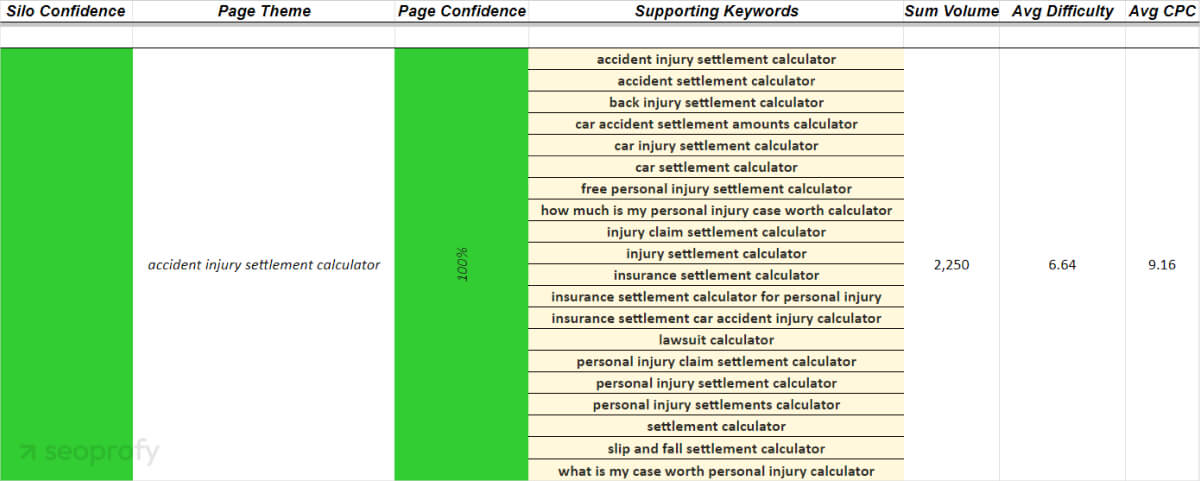
It’s also important to check if all the keywords in your cluster show up on the same search engine results page (SERPs). If they do, it means they’re related, which is a good sign for your content strategy. This way, you can create content that really meets what users are looking for.
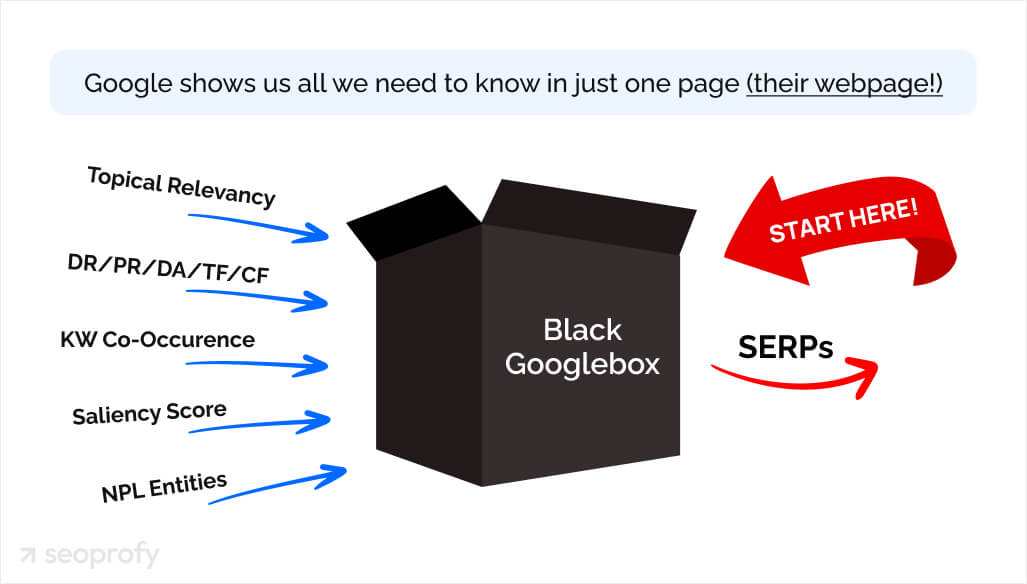
Select Primary and Secondary Keywords
A primary keyword, also called a “target keyword,” is the main term that best represents your page’s topic. It’s usually the most searched-for word or phrase, and you’ll use it to guide how you optimize the page. By placing it in key spots, you can help search engines and users understand what your content is about. Here’s where to include it:
- Meta tags (title and description): It tells search engines what your page is focused on. While this doesn’t directly affect rankings, it can boost clicks if searchers see it matches what they’re looking for.
- Main heading (H1): This lets both readers and search engines know the main subject of the page right away.
- First paragraph: Mentioning it early on gives users a clear idea of what they’re reading about.
- URL: Including the keyword makes your URL clearer and more SEO-friendly.
Every page should focus on only one primary keyword. This saves you from potential keyword cannibalization, where multiple pages fight for the same search term.
You can also add secondary keywords, which are related phrases or synonyms that support the main keyword. For instance, if your primary search term is “family lawyer,” secondary keywords might include “divorce attorney” or “child custody lawyer.” These can be used throughout the text to add variety without overusing the main term.
But try not to overdo it. Once you have your primary keyword, optimize the page around it without forcing it everywhere. Sprinkle in a few secondary keywords, but keep your writing natural and easy to read. Search engines are smart enough to understand your page’s focus without excessive repetition.
One thing to steer clear of is keyword stuffing, which is cramming too many keywords into your content. It doesn’t help rankings and can make your page harder to read—plus, Google may penalize you for it.
You can also use your keywords to optimize things like image alt text, internal links, and even structured data. All of these small details help improve your overall SEO performance.
Advanced Keyword Research Techniques
Now that we’re done with the basics, let’s go over some more advanced techniques you can use for your keyword strategy:
Use Latent Semantic Indexing (LSI) and Semantic Keywords
LSI keywords are variations that allow a search engine to contextualize your content better. Although latent semantic indexing isn’t a direct ranking factor in Google per se, it supports your primary keyword while also:
- Improving the overall relevance of your content
- Helping you avoid keyword stuffing
- Increasing your chances of ranking for related searches
You can add these keywords naturally throughout your subheadings, body content, or even image alt text. To find LSI keywords, tools like Google’s “People Also Ask,” Ahrefs, or LSIGraph are great resources.
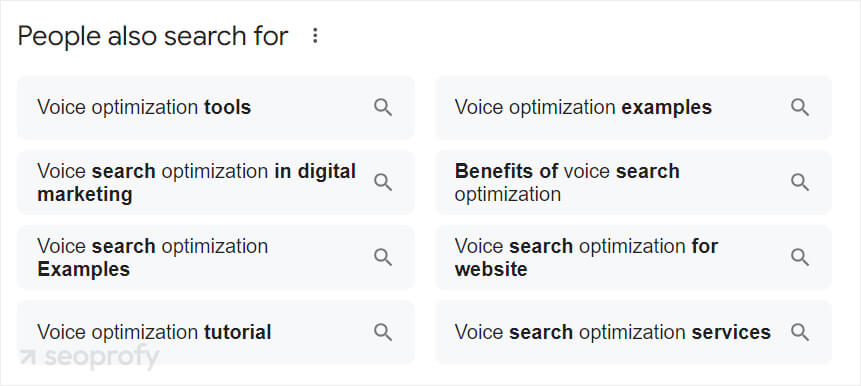
Optimize for Voice Search and Question-Based Keywords
Voice search is growing fast, and with more people using Siri, Alexa, and Google Assistant, it’s important to adapt. Here’s how to make your content more voice-search friendly:
- Target question-based, long tail keywords
- Use conversational language in your content
A tool like AnswerThePublic can show you popular questions people are asking about your topic. Besides, don’t forget to check the “People Also Ask” section in Google—it’s another great source for finding question-based keywords to use in your strategy.
Conduct Competitor Keyword Analysis
Competitor analysis is probably the easiest way to find good keywords for SEO. Simply head over to Ahrefs’ Keywords Explorer and enter your competitor’s domain. This will give you a list of all the keywords they rank for.
Go over those keywords and focus on the ones with good search volume that they’re doing well on but you’re missing. These are your keyword opportunities.
Want to get the most out of your keywords? SeoProfy is here to help with our professional keyword research services and more. Our team uses in-house and industry-leading SEO tools to find high-value keywords, so you can rank higher and attract more leads. We’ll help you to:
- Evaluate competition
- Analyze SERPs
- Identify search intent

Common Mistakes to Avoid in Keyword Research
We all want to target the right keywords, but sometimes we make choices that can set us back. From choosing keywords for SEO with the highest volume to overlooking search intent, these pitfalls can waste your time and effort. So let’s take a look at these mistakes to help you avoid them in your strategy:
Ignoring Search Intent and Relevance
One of the mistakes businesses most frequently make regarding keyword strategy is not paying attention to the search intent behind the keywords. As we mentioned, understanding why users are searching for something and what they actually hope to find is very important for ranking well on Google.
For example, take the keyword “best pizza recipes.” Users who search for this phrase are likely interested in cooking instructions rather than places to order pizza. In other words, your content has to correspond with the user’s intent. Otherwise, it won’t rank in top positions
Additionally, if the intent isn’t aligned with your content, you may attract visitors who won’t convert into customers. So try to always prioritize relevance and user intent to make sure your content meets the needs of your audience.
Overemphasizing High-Volume Keywords
If you’re solely targeting high-volume keywords, you could be overlooking better opportunities. High-volume terms often don’t align with what users really need. That means they probably won’t deliver the right customers to your doorstep. And, since everyone is after those popular terms, it can take a long time before you get noticed.
Instead, focus on mid- and long-tail keywords. The search volume may be lower, but they are highly targeted and far easier to rank for. Zeroing in on these will help you attract better-qualified traffic and reach the proper audience.
Neglecting Local SEO Keywords
Some businesses forget to use local keywords in their search engine optimization strategy and this can be a big miss if you’re targeting a specific area. For example, if you run a coffee shop in Chicago but aren’t using phrases like “best coffee in Chicago” or “coffee shops near me,” people nearby who are searching for exactly what you offer won’t be able to find you.
So next time you plan your keyword list, try to add relevant local search terms as well. This will help you attract more local customers to your business. You’ll also get better visibility in local search results, and improve your chances of showing up in Google’s local pack, and even voice search results.
Ready to Find the Right Keywords for Your SEO?
We’ve discussed many useful strategies to help you pick the best keywords for your SEO. And now you know what keywords to prioritize, what mistakes to avoid, and which tools to use to speed up this process. If all of this feels overwhelming and you need some professional support, SeoProfy can take this off your busy schedule.
We take a data-driven approach, which means we analyze your competitors, search intent, and keyword difficulty to sift through irrelevant terms and find the ones that will be of high value to your business.
If you’d like to learn more, schedule your complimentary consultation today, and let’s discuss how our experts can help you grow your business.









